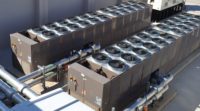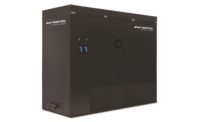
Data centers are expensive propositions, so incorporating some free cooling is financially attractive as well as green. However, reaching the real savings involves more than just incorporating economizers. You need the controls to execute an overall sequence of operation that handles the transitions in chilled water plant performance, too.
A few circumstances are fueling the move to incorporate sustainable designs into data center infrastructure systems. These include the high energy demands of data centers, rising energy costs, and changes in many building codes to require some form of economizer as part of the mechanical system design. As a result, outside air economizers (free cooling) are being considered as one approach to meeting more sustainable design criteria. Outside air economizers offer a significant potential for reducing hours of mechanical cooling operation.
The use of outside air economizers introduces concerns about reliability as systems transition between free cooling and chilled water plant operation (DX cooling is not addressed here). In order to address these issues, we must understand when the economizer is in operation as well as the load on the chilled water plant during economizer operation.
Economizer Operation
Outdoor air economizers utilize the hours in which the enthalpy of the outdoor air is less than that of the return air. During these periods, the use of outdoor air will reduce the load at the AHU when compared with the load associated with return air. The economizer presents three options for operation:- No economizer - Outdoor air enthalpy greater than return air enthalpy: During this period no outside air is introduced to the AHU. The AHU and chiller plant see the full load of the data center. Full mechanical cooling is required.
- Partial economizer - Outdoor air enthalpy lower than return air and higher than supply air setpoint: During this period, the load on the AHU is reduced but some mechanical cooling is still required.
- Full economizer - Outdoor air enthalpy lower than return air and supply air setpoint: During this period the supply air setpoint is met by either 100% outside air or by mixing outside air with return air. No mechanical cooling is required during this period.
New thermal guidelines may result in supply air temperatures in the range of 68°F (20°C) db. Chilled water temperatures will elevate with the in-crease in supply air temperatures. The resulting available hours of economizer operation in southern U.S. climates can be greater than 50% and up to 100% in northern climates. It is important to consider any minimum ventilation requirements for support spaces that may require a lower chilled water temperature for dehumidification.
Reliability
When specifying control systems for the mission critical industry, there are many factors that need to be accommodated. First and foremost is reliability. Once the design engineer meets the need for more ductwork associated with the economizer and compensates for steady-state environmental conditions controls for the white space, the application of a comprehensive controls system introduces a level of re-thinking. Economy of operation and reliability are now partners in the hierarchy of demands. The need for more precise control and chilled water availability are crucial when considering the reliability of a data center.The smooth transition between straight mechanical cooling and the application of free cooling using outside air needs to address performance reliability in the chilled water plant. When free air cooling was not taken advantage of, the chilled water plant load was fairly constant. Only a small portion of the chilled water load was reduced from those limited AHUs with outside air economizers serving non-critical areas, usually administrative and support areas.
With the airside economizers serving a large percentage of the total chilled water plant load, sequencing of economizer modes of those AHUs could have detrimental impact on the chiller plant performance if done improperly. For example, as outside air conditions improve and it becomes advantageous to utilize free air cooling, AHUs with economizers will be released from a minimum position to modulating control to maintain a discharge setpoint. Depending on the setpoints utilized to enable economizer operation, large portions of the chiller plant load will be quickly relieved. In chilled water plants with multiple chillers operating, the sudden unloading of these units could cause them to shut down because the evaporator differential is below the units’ control setpoint to enable operation. This will cause an interruption of stable chilled water supply to the building load. If a chiller is shut down by its internal safeties, it will require a manual reset.
Control strategies must be employed to allow the staged introduction of free air cooling in economizer-equipped AHUs while enabling the chiller plant to respond properly. With a managed chilled water plant load reduction, the chiller plant control software will be able to react by reducing the number of operating chillers in an orderly fashion. This method of economizer staging will keep sufficient load on the remaining operating chillers so a stable chilled water supply can be maintained without interruption.
Introduction of chilled water plant load must also be staged as outside air conditions deteriorate and airside economizers are indexed to minimum position. In this scenario, building AHUs with economizers should slowly stage or ramp to minimum position to afford time for the chiller plant to stage up. Enabling/disabling of the building AHU economizer modes and chiller plant staging timing parameters in the control system need to be properly coordinated to maintain stable operation when transitioning economizer modes.
Design Issues
Factory-supplied control modules on the air-handling equipment, especially computer room AHUs, must be able to control the airside economizer. The design engineer should verify this capability and the ability to coordinate economizer staging functions with the chiller plant control system within the BAS. It may be desirable to have the building automation vendor supply control modules for these units to ensure total system functionality.Also, with increased data exchange and interdependency between AHUs and chiller plant control system components, the need for a robust, fault-tolerant control system communications topology is elevated. Distributed control panel communications should have a redundant path between vital system components to ensure total control system integrity. Ethernet communications architecture with a fault-tolerant “ring topology” backbone between critical control panels should be the minimum level of implementation. An MSTP (daisy-chain master slave token passing) type of communication structure should not be utilized as it does not provide a redundant communication path if the MSTP network is compromised.
Control system design needs to recognize the necessity of monitoring chilled water and airflow conditions at sufficient point densities. This will ensure adequate data gathering for system performance analysis as the facility grows. The majority of facilities realize minimum loads for long periods of time, skewing the design intent of maximum load. During these crucial low-load conditions, the distributed control system and available data values become even more critical in making the necessary adjustments to operation prior to the introduction of design loads.
The sequence of operation for the chilled water plant should provide detail for when the chilled water plant should be disabled or enabled. The de-signer needs to consider the amount of time required for the chilled water plant to start and provide chilled water to the load. If the facility is operating at full outside air economizer and one of the computer room units requires additional cooling, the chilled water plant will need to be started as quickly as possible to provide the additional cooling without compromising the data center environment. Additional AHU economizers may need to be transitioned to minimum position to introduce enough load to the chilled water plant for stability. Once the chilled water system is enabled, a minimum run time should be considered to prevent equipment short cycling.
With the introduction of outside air comes the need for freeze protection. The traditional approach to freeze protection at the AHUs is due for re-evaluation. The layout and design of the outside air system as well as the freeze protection safeties need to address performance reliability. The airside system design needs to provide adequate mixing of outside air and return air to prevent critical unit shutdown due to cold air stratification causing the freezestat to trip.
Give consideration to the operating state of the chilled water system when the data center is under full economizer mode. The availability of this system is crucial in the event of an outside air economizer system failure. Determine the minimum capacity at which the chilled water plant can operate safetly. This threshold is a factor in the transition from full outside air economizer to mechanical cooling. In systems that include thermal storage within the design, the thermal storage can be utilized to provide chilled water to the load for the short time period between when the chilled water plant has been enabled and when it begins to produce chilled water at setpoint.




